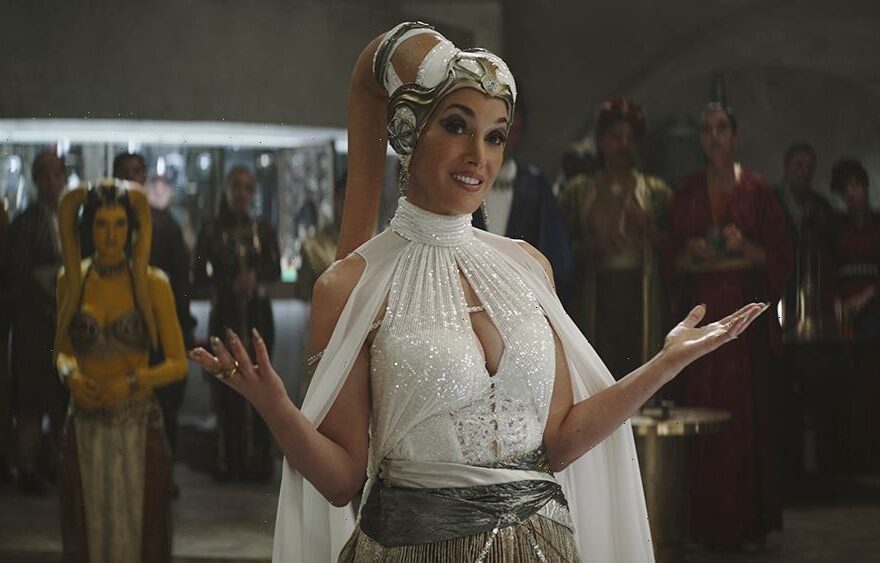Since the very first movie premiered in 1977, “Star Wars” has been a franchise with a clearly identifiable aesthetic: rusty armor, billowing capes and a retro vibe firmly entrenched in ’70s science fiction. Later iterations of the franchise would update or play with that look to varying extents, but “The Book of Boba Fett” miniseries on Disney Plus is a full-fledged resurgence of the original trilogy’s magic, thanks to the work of costume designer Shawna Trpcic.
A hardcore “Star Wars” fan, Trpcic first joined the franchise during season 2 of “The Mandalorian.”
In preparation for diving into the show’s spinoff “The Book of Boba Fett,” she studied the original making-of books that George Lucas created during production of the first movie, which provided templates for the original designers like production illustrator Ralph McQuarrie and costume designer John Mollo to follow. Then, she started working to create costumes that looked and felt like they belonged right back in 1977.
“I am very aware of the aesthetic that George Lucas had in 1977 and 1983, and I’m very aware of the technology that they did or didn’t have,” Trpcic says. “So one of the things I tried to do is use tools and resources that would have been available to them.”
For example, Trpcic would look for jackets from the ’40s, which would have been vintage when the first film was being shot. Unlike modern superhero costumes, which often print details on top of Euro jersey fabric, Trpcic and her team also focused on using real embroidery and fabric treatments for the vast majority of clothing characters wear over the course of the show. Many outfits relied on using raw silks and homespun cotton in order to convey the run-down, natural vibes of the desert planet Tatooine, where the majority of the story takes place.

“With ‘Book of Boba Fett,’ having things that seemed handwoven, or that had the texture and the weaves that you could almost picture being brought down on the loom and woven in between, it was important to me,” Trpcic says.
One set of characters these hand-woven materials were vital for were the nomadic Tusken Raiders, who wear long cloth robes and masks that hide their features. A mainstay of the franchise that first appeared all the way back in the original movie, the Tusken Raiders are hugely fleshed out in the miniseries, given a more clearly established culture and far greater prominence. While she for the most part stayed loyal to their original designs, Trpcic experimented with their details to help distinguish them from each other, adding things like longer dreadlocks for one prominent female warrior and charcoal and clay decorations on their masks that helped the viewer identify individual characters in the tribe that Boba Fett encounters.

“Book of Boba Fett” also introduces new groups and factions into the universe, such as the Mods, a street gang operating in Mos Espa with cybernetic implements. The characters have vastly different costumes than what’s found in most “Star Wars” media, with a look that wouldn’t be out of place in a cyberpunk setting. According to Trpcic, this was intentional; the Mods were the brainchild of series writer Jon Favreau, who wanted the characters to have a retro punk aesthetic; their leader, Drash (Sophie Thatcher), was intentionally modeled after Joan Jett. Trpcic used a plethora of zippers for the Mods outfits and collaborated with a famous graffiti street artist (whose name she kept confidential) to design the details for Drash’s jacket. While the outfits may look slightly more modern, Trpcic still used most of the classic techniques and material for creating them. For example, when designing the look of a Mod, played by the popular musician Thundercat, Trpcic designed a classic Lando-esque fabric, using material from a vintage British company that has wool on one side and a plastic raincoat fabric on the other.
“I would try to find fabrics that were familiar in the ‘Star Wars’ universe, but use them in a more modern tech-looking way,” Trpcic says.

Creating all of the costumes for “Book of Boba Fett” took a lot of manpower and work. Every outfit, from those worn by background characters to the armor of Boba Fett himself, had their designs come from hours of research and building by Trpcic and her team, and every single fabric was tested to make sure it worked properly for the show. For characters like Boba Fett, the team makes as many as six different copies of the outfits for backup. Occasionally, prep times are incredibly short; at one point, the team had to construct an elaborate, quilted outfit with belting and pockets for an actor who was cast last minute in a span of three hours. Another time, the crew had to rapidly make doubles for the Tusken Raider characters after director Robert Rodriguez decided at the last minute that he wanted a shot of them burning in a pile for episode three.
For Trpcic, however, that effort was well worth it, as she considers every outfit its own unique work of art, and she loves being able to see and touch every single costume before it goes on camera.
According to Trpcic, her method of recapturing the original film’s look seems to have paid off, with most reactions to the costumes she’s seen being positive.
“What I’m seeing with the fans is that it’s ringing true,” Trpcic says. “It’s almost subconscious, they’re like ‘oh yeah, that’s Star Wars.’ And that’s the biggest compliment ever.”
Source: Read Full Article
